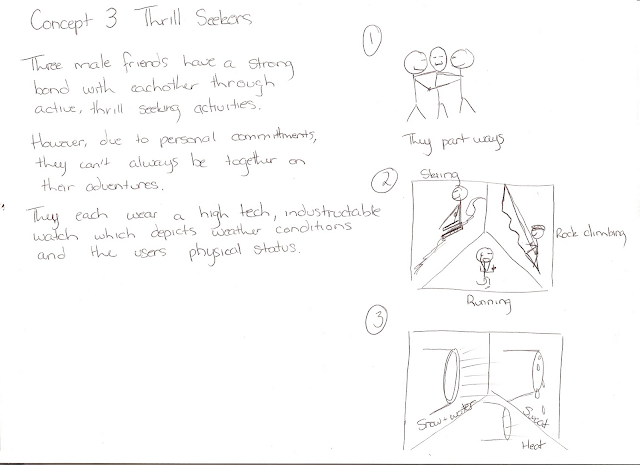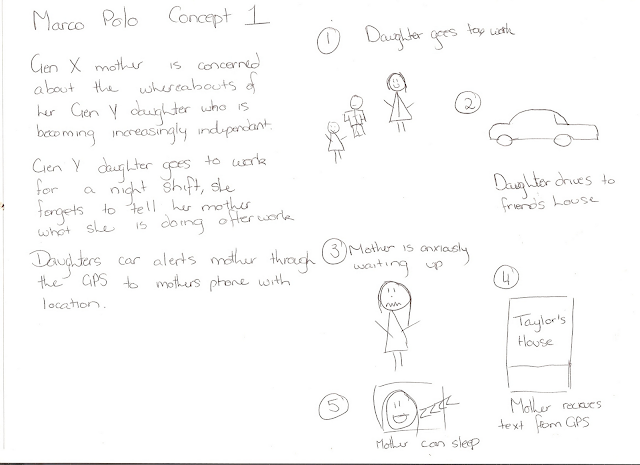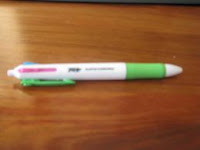Our aim was to refine the concept back to the user group/scenario and investigate that through developing persona’s, which was advised by Matt. We then went back and forth unsuccessfully throwing solutions together, none of which were suitable for our target market. It was a fairly unsuccessful hour or so where we did not make much progress. Marianella then said to ignore the user group and start with the behaviour of the product, aka. What the product would allow the user to do, rather than zoning in a particular target market and developing personas. I found this conflicting information very confusing but we went with what Marianella had said. The behaviour of the product would be that it would allow the user to see how there friend/friends or family members were doing at a glance. We thought this product could have the option of being portable to allow the user to transport the product between the home and office locations. The details of our target market began filling out, we were going to design for a busy businessman or woman who travels a lot and/ or is away from there family often. We set the task for next week to try and think how the friends and family and their moods could be represented.
Wednesday, 31 August 2011
Deciding on a Concept
The process we took to decide on a concept was to discuss the concepts in detail and provide feedback to eachother. First of all we discussed my concept and there was concern that this concept did not have enough room to change and further the idea. Also it was mentioned that the plant may take a long period of time to show any signs of not being watered as many plants only need to be watered once a week or so. Although Lisa and Yoakim did like the concept so we began brainstorming other ways that mood could be represented through a living or non living form. Some solutions included 'fake fish' which could mimic the mood of the user. I didn't really like that suggestion as I struggle to find how our market would find appeal in this.
We moved on to Yoakim's idea of the security sensored sound effects/ novelty, however, due to it not showing interaction between two friends or family members it was ruled out quite quickly. We did brainstorm ways that the system could enhance interaction, but we struggled to find how it be related between friends or family. This was because once user would automatically be the person committed a crime and therefore would not have a relationship with the purchaser of the product. It could be something which alerts the security company in control of the system. Another issue stood out with the system being that if the product was on the market the offender may be aware of the sound effects which are there to scare them off, therefore making the system inefficient in its purpose.
Lisa's concept was the 'drunk watch' to monitor how drunk your friend is and transmit the same information to them. It began as a concept aimed at competing with your friend in how drunk you could get. There are huge health and safety issues contained in that purpose though and that idea was scrapped. Her purpose then stood at monitoring how good a time the friends were having in the different locations based on how drunk they were. Yoakim and I weren't sure about the scenario however it was targeted at more of a safety object it could work. Tim questioned the concept though, asking why, why does the friend want to know, if they are both drinking what can they do for eachother anyway if they are in different locations. We also questioned how it could work automatically, measuring alcohol levels in breath involved 5 whole seconds of constant exhale and therefore this reading could not be taken without the user consciously deciding to use a breathalyser.
We decided to go with my concept, however we brought it right back to the problem and scenario and eliminated the solution.
Sunday, 28 August 2011
Saturday, 27 August 2011
Process
To show the process was going to be the hardest task and I was unsure of how to do this so I wrote out a detailed story which I could then refine back to a story board idea.
The plants are purchased in a set of two by either person (daughter, mother, son , father, friend etc.)The kit containing two specialized sprinkler parts, two lengths of PVC hose, two timers and two sensored rings is bought also.
These are distributed amongst the two users and the plants and kits are assembled in an outdoor environment. The assembly entails the sprinkler part being inserted into the plant and then connected to the pvc hose which is then connected to the timer which connects to the tap. There are two sensors per user, one which is situated on the head of the sprinkler and one which is on the ring.
The timer is set to water as necessary for the period of time required (dependant on the plant).When the sensor detects a negative mood the head of the sprinkler contracts to block the exit of water. If a positive mood is detected it will either expand or stay open depending on whether it was open already. Each plant corresponds with the opposite user.
In time the plants will begin to reflect the general mood of the user which works well when determining if they other person needs some company.
Thursday, 25 August 2011
From there, I made a list of what I needed to begin making a model, this included;
Pot and plant
Sprinkler
PVC pipe
Something to stop the water from being released.
Off I went to Bunnings and pretty much immediatly got help from an employee in the irrigation section.
I explained to him my situation and we found the most suitable sprinkler and pick rather quickly. My only worries was that as far as aesthetics go, the pick was rather large and they did not have a smaller size. He said the only other option would be to use a dripper, but I would have to buy each part in packs and this would be rather expensive for the purpose of one mock up model. I then found the PVC pipe which would connect the sprinkler to the tap through a puncture hole. I looked through the various timers, which ranged from ones which had to be turned on and off, and those which were completely automated, to those which could detect rainfall and would cease watering accordingly. Of course the more complex and efficient, the higher cost involved which ranged to about $100. I thought for the purpose of this task if would not be necessary to purchase a timer. As far as a stopper to block the water, there was really nothing which could be inserted and removed as I had planned. If I cut into the PVC hose it would pretty much be useless. If I put a stopper in the head of the sprinkler it would have the same impact. Therefore I'm thinking a cap over the head which would be airtight and could be removed. I'm not sure how this could be automated though.
Pot and plant
Sprinkler
PVC pipe
Something to stop the water from being released.
Off I went to Bunnings and pretty much immediatly got help from an employee in the irrigation section.
I explained to him my situation and we found the most suitable sprinkler and pick rather quickly. My only worries was that as far as aesthetics go, the pick was rather large and they did not have a smaller size. He said the only other option would be to use a dripper, but I would have to buy each part in packs and this would be rather expensive for the purpose of one mock up model. I then found the PVC pipe which would connect the sprinkler to the tap through a puncture hole. I looked through the various timers, which ranged from ones which had to be turned on and off, and those which were completely automated, to those which could detect rainfall and would cease watering accordingly. Of course the more complex and efficient, the higher cost involved which ranged to about $100. I thought for the purpose of this task if would not be necessary to purchase a timer. As far as a stopper to block the water, there was really nothing which could be inserted and removed as I had planned. If I cut into the PVC hose it would pretty much be useless. If I put a stopper in the head of the sprinkler it would have the same impact. Therefore I'm thinking a cap over the head which would be airtight and could be removed. I'm not sure how this could be automated though.
Thursday, 18 August 2011
Design Evolution
My thoughts of the design evolved from the initial watering cup idea to a sprinkler idea due to the fact that it would ruin the beauty of the plant or flower if wire and some sort of cup was attached.
A sprinkler system would also be easier to attach to the plant itself. The following image documents my design evolution. My thoughts are that the PVC hose would be connected to a timer which would then connect to the tap. The timer would be set how often as needed and the plant would be automatically looked after. However, if the other person was experiencing unhappiness or were in an unstable emotional state this would send a sensor through to the system, which would then block the water from being administered through the sprinkler system during the time specified.
A sprinkler system would also be easier to attach to the plant itself. The following image documents my design evolution. My thoughts are that the PVC hose would be connected to a timer which would then connect to the tap. The timer would be set how often as needed and the plant would be automatically looked after. However, if the other person was experiencing unhappiness or were in an unstable emotional state this would send a sensor through to the system, which would then block the water from being administered through the sprinkler system during the time specified.
Emotion Detection
Two resources which detailed Body Sensor Networks and Wireless Body Sensor Networks are listed below.
http://www.capsil.org/system/files/Chapter+5.pdf
http://docs.google.com/viewer?a=v&q=cache:-qqnJQVqwQAJ:www.ist-esense.org/fileadmin/images/PDF_Deliverable/e-SENSE_WP5_D.5.3.1.pdf+wireless+sensor+networks+to+detect+mood&hl=en&gl=au&pid=bl&srcid=ADGEESgFkR9_L7u2UKGkIGu4PuVoDnDcn3vpthoHU2JCo_3X-8J91cjc5-_DiaSehbTqmKHiAkJ-0JZG97WbrzwDWT7yUs2qGV-qVDe750RHrEhnWPXer2d8XuqaCXF9Q4Gr3IVgJEuj&sig=AHIEtbSxsayhvSGEky0O8kgPRIO4CoF_lw&pli=1
However after studied these papers I still found them confusing and wasn't sure if this is relevant to my research and if these papers conclude that emotional detection is possible.
The relevance of this is that it determines whether the user has to input their emotional state or whether it can be detected automatically.
http://www.capsil.org/system/files/Chapter+5.pdf
http://docs.google.com/viewer?a=v&q=cache:-qqnJQVqwQAJ:www.ist-esense.org/fileadmin/images/PDF_Deliverable/e-SENSE_WP5_D.5.3.1.pdf+wireless+sensor+networks+to+detect+mood&hl=en&gl=au&pid=bl&srcid=ADGEESgFkR9_L7u2UKGkIGu4PuVoDnDcn3vpthoHU2JCo_3X-8J91cjc5-_DiaSehbTqmKHiAkJ-0JZG97WbrzwDWT7yUs2qGV-qVDe750RHrEhnWPXer2d8XuqaCXF9Q4Gr3IVgJEuj&sig=AHIEtbSxsayhvSGEky0O8kgPRIO4CoF_lw&pli=1
However after studied these papers I still found them confusing and wasn't sure if this is relevant to my research and if these papers conclude that emotional detection is possible.
This is the best and clearest example which shows the mood detection technology has been available since 2006 and has been used by NASA. Exmocare is designing the second model of this product which is said to be smaller, smarter, blue tooth enabled version.
The BT2 is going to be produced in larger quantities and passed through the elderly care system which shows that the product is going to be accessible soon.
http://medgadget.com/2008/03/exmocare_emotion_detection_technology_capitalizing_on_how_r_u.html
http://medgadget.com/2008/03/exmocare_emotion_detection_technology_capitalizing_on_how_r_u.html
The relevance of this is that it determines whether the user has to input their emotional state or whether it can be detected automatically.
This concept was thought up after the feedback of our concept bombs was given. I really favoured this concept due to the mimicry of the wellbeing of the person to the plant. I spoke to Marianella about the concept and she really liked it so I was really pleased to move forward with this one. My idea is that a watering cup/bucket is able to lift and tilt to water the plant without the user's involvement. However, I don't really see that I will be able to do so for next weeks class. My question that I need to answer is whether it is possible for mood to be detected through a slimline portable device whether being a wristband etc. Also is this information going to be able to be communicated wirelessly to the plant which could then activate the watering function.
Wednesday, 17 August 2011
Peer Feedback- Concept Bomb
It was surprising to see the similarity between ideas between people in class with many of the 'Missing You' concepts being pillow based, or based around going to sleep with the comfort of the partner. Many of the designs were alert systems through rings or bracelet or other forms.
The peer feedback was quite balanced between my second and third concepts which surprised me being that the third was my least favourite. I did not really favour my second concept due to the similarity to others and how far fetched the idea was.
Looking around the room at some great concepts really sparked an idea in my mind to link the wellbeing of a person with a living thing, which is acknowledged in my next post.
Tuesday, 16 August 2011
Object/Behaviour/Scenario
The Music Box
The user winds the music box opens it up and its music to the ears. When closed the music stops.
Hacking Material
The pen was disassembled into three parts, which made the user's behaviour of selecting a colour and using the pen impossible.
This task was done individually as I was sick and missed the hacking material task in class and the workshop.
Monday, 15 August 2011
Multi Use/ Integration of Function
Many products at Life Tec were suited to multiple tasks, for instance;
The wheeled walker frame is an example of an integrated assistive technology as it assists the user in everyday mobility through supporting the person from falling forwards and minimising weight to support. Similarly, it acts as a seat, however it does not have back support. In addition to these functions the user can also use the basket for storage.


The wheeled walker frame is an example of an integrated assistive technology as it assists the user in everyday mobility through supporting the person from falling forwards and minimising weight to support. Similarly, it acts as a seat, however it does not have back support. In addition to these functions the user can also use the basket for storage.

For those limited quite severely in mobility and strength multi positioning tilt chairs are available which allows the user to sit and be social, in an upright stance or recline to relax or sleep if getting in and out of the chair is hard. Similarly recliners are available which gently ease the user out of the chair to an upright position to assist with those who lack the strength necessary.

Monday, 8 August 2011
Life Tec.
"Assistive technology is a device or system that provides people with practical solutions to everyday life activities."
The beauty of technology that adheres to those with more specialised needs, is that it generally suitable for all target markets.
Assistive Technological Aids can be categorised accordingly.
- Aids for daily living:
- Alternative and augmentative communication:
- Mobility aids:
- Seating and positioning:
- Computer access aids:
- Environmental controls:
- Home/Workplace modifications:
- Prosthetics and orthotics:
- Sensory aids for vision/hearing impaired:
- Recreation:
I was surprised at the extent of technology available for carers, to allow awareness of patients at all times. For instance the bed side mat that detected weight and therefore would alert the carer if the patient had gotten out of bed via an alarm system. This particularly sparked my interest as I had a grandfather with alzheimer's disease and I know how people affected by memory loss can often go walkabouts. This is probably an area of assistive design that I would be interested in continuing my research in.
In contrast to this, milder weaknesses were also catered for at Life Tec with the simple Jar Key being available. This is a utensil I constantly have to use to open jars due to weakness in the wrists. This simply exemplifies that whether mild or intense, the prevalence of assistive technologies are very important.
Monday, 1 August 2011
Potential Design of Assistive Technologies
Brainstorming Potential Assistive Technologies
A shoe could detect the route which the user has taken this could then be uploaded and new routes could be determined from this information.
Shoe temperature control to warm your shoes in winter or cool your shoes in summer.
Air travel could be a great aspect to look at with an object simulating circulation through the feet of the user, whether being a footrest or socks or shoes
Backpack which alerts user when his or her backpack has been opened via vibration or alarm to deter or alert those trying to mug the user.
Water bottle alerting user as to how much water they have had and how much they need to have.
Bank card which tells the user if they have enough money for the purchase prior to using the card. Avoids embarrassment and avoids financial debt.
Calorie Counter Clothing
Mood reactive clothing- colour alters depending on mood.
Tangible Experiences
Tangible experiences
Group Brainstorming Session
Clicking a pen
Flipping a Light Switch
Volume Dial
Turning the Door Handle
Twisting a Lock
Pressing a Button to Activate Action
Playing Musical Instruments via Pressing, Tapping, Plucking, Gripping and gliding bow.
Assistive Technologies
Examples of Assistive Technology
Group Brainstorming Session
Subtitles
Closed captions
Microphone-speaker in ear earphones
Global Positioning System
Hearing Aid
Glasses
Mobility Aids
Fall Detectors for the Elderly
Can openers
Bottle openers
Jar Keys
Haptic Device
Subscribe to:
Comments (Atom)















